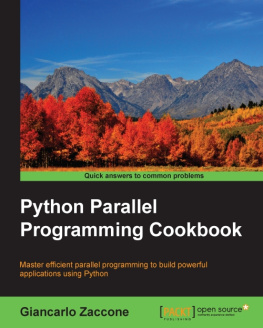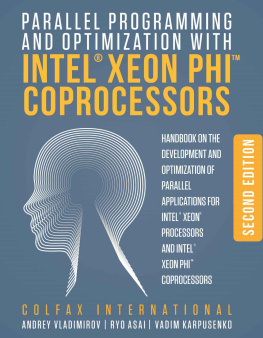Aubanel - Elements of Parallel Computing
Here you can read online Aubanel - Elements of Parallel Computing full text of the book (entire story) in english for free. Download pdf and epub, get meaning, cover and reviews about this ebook. City: Boca Raton, year: 2016, publisher: Chapman and Hall/CRC, genre: Home and family. Description of the work, (preface) as well as reviews are available. Best literature library LitArk.com created for fans of good reading and offers a wide selection of genres:
Romance novel
Science fiction
Adventure
Detective
Science
History
Home and family
Prose
Art
Politics
Computer
Non-fiction
Religion
Business
Children
Humor
Choose a favorite category and find really read worthwhile books. Enjoy immersion in the world of imagination, feel the emotions of the characters or learn something new for yourself, make an fascinating discovery.
- Book:Elements of Parallel Computing
- Author:
- Publisher:Chapman and Hall/CRC
- Genre:
- Year:2016
- City:Boca Raton
- Rating:3 / 5
- Favourites:Add to favourites
- Your mark:
Elements of Parallel Computing: summary, description and annotation
We offer to read an annotation, description, summary or preface (depends on what the author of the book "Elements of Parallel Computing" wrote himself). If you haven't found the necessary information about the book — write in the comments, we will try to find it.
Designed for introductory parallel computing courses at the advanced undergraduate or beginning graduate level, Elements of Parallel Computing presents the fundamental concepts of parallel computing not from the point of view of hardware, but from a more abstract view of algorithmic and implementation patterns. The aim is to facilitate the teaching of parallel programming by surveying some key algorithmic structures and programming models, together with an abstract representation of the underlying hardware. The presentation is friendly and informal. The content of the book is language neutral, using pseudocode that represents common programming language models.
The first five chapters present core concepts in parallel computing. SIMD, shared memory, and distributed memory machine models are covered, along with a brief discussion of what their execution models look like. The book also discusses decomposition as a fundamental activity in parallel algorithmic design, starting with a naive example, and continuing with a discussion of some key algorithmic structures. Important programming models are presented in depth, as well as important concepts of performance analysis, including work-depth analysis of task graphs, communication analysis of distributed memory algorithms, key performance metrics, and a discussion of barriers to obtaining good performance.
The second part of the book presents three case studies that reinforce the concepts of the earlier chapters. One feature of these chapters is to contrast different solutions to the same problem, using select problems that arent discussed frequently in parallel computing textbooks. They include the Single Source Shortest Path Problem, the Eikonal equation, and a classical computational geometry problem: computation of the two-dimensional convex hull. After presenting the problem and sequential algorithms, each chapter first discusses the sources of parallelism then surveys parallel algorithms.
Aubanel: author's other books
Who wrote Elements of Parallel Computing? Find out the surname, the name of the author of the book and a list of all author's works by series.









